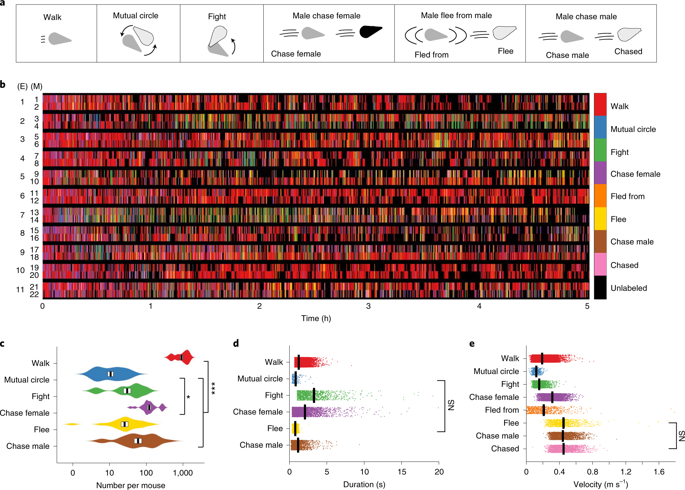当前位置:
X-MOL 学术
›
Nat. Neurosci.
›
论文详情
Our official English website, www.x-mol.net, welcomes your
feedback! (Note: you will need to create a separate account there.)
Ultrasonic signals associated with different types of social behavior of mice.
Nature Neuroscience ( IF 21.2 ) Pub Date : 2020-02-17 , DOI: 10.1038/s41593-020-0584-z Daniel T Sangiamo 1, 2 , Megan R Warren 1 , Joshua P Neunuebel 1
Nature Neuroscience ( IF 21.2 ) Pub Date : 2020-02-17 , DOI: 10.1038/s41593-020-0584-z Daniel T Sangiamo 1, 2 , Megan R Warren 1 , Joshua P Neunuebel 1
Affiliation

|
Communication plays an integral role in human social dynamics and is impaired in several neurodevelopmental disorders. Mice are used to study the neurobiology of social behavior; however, the extent to which mouse vocalizations influence social dynamics has remained elusive because it is difficult to identify the vocalizing animal among mice involved in a group interaction. By tracking the ultrasonic vocal behavior of individual mice and using an algorithm developed to group phonically similar signals, we showed that distinct patterns of vocalization emerge as male mice perform specific social actions. Mice dominating other mice were more likely to emit different vocal signals than mice avoiding social interactions. Furthermore, we showed that the patterns of vocal expression influence the behavior of the socially engaged partner but do not influence the behavior of other animals in the cage. These findings clarify the function of mouse communication by revealing a communicative ultrasonic signaling repertoire.
中文翻译:

与小鼠不同类型的社交行为相关的超声波信号。
交流在人类社会动态中起着不可或缺的作用,并在几种神经发育障碍中受损。小鼠被用来研究社交行为的神经生物学。但是,由于很难在参与群体互动的小鼠之间识别发声动物,因此小鼠发声对社会动态的影响程度仍然难以捉摸。通过跟踪单个小鼠的超声发声行为,并使用开发来对语音相似信号进行分组的算法,我们显示出,随着雄性小鼠执行特定的社交动作,发声的模式也会不同。与避免社交互动的小鼠相比,支配其他小鼠的小鼠更有可能发出不同的声音信号。此外,我们发现,声音表达的模式会影响社交伙伴的行为,但不会影响笼中其他动物的行为。这些发现通过揭示可通信的超声波信号表来阐明鼠标通信的功能。
更新日期:2020-02-17
中文翻译:

与小鼠不同类型的社交行为相关的超声波信号。
交流在人类社会动态中起着不可或缺的作用,并在几种神经发育障碍中受损。小鼠被用来研究社交行为的神经生物学。但是,由于很难在参与群体互动的小鼠之间识别发声动物,因此小鼠发声对社会动态的影响程度仍然难以捉摸。通过跟踪单个小鼠的超声发声行为,并使用开发来对语音相似信号进行分组的算法,我们显示出,随着雄性小鼠执行特定的社交动作,发声的模式也会不同。与避免社交互动的小鼠相比,支配其他小鼠的小鼠更有可能发出不同的声音信号。此外,我们发现,声音表达的模式会影响社交伙伴的行为,但不会影响笼中其他动物的行为。这些发现通过揭示可通信的超声波信号表来阐明鼠标通信的功能。











































 京公网安备 11010802027423号
京公网安备 11010802027423号